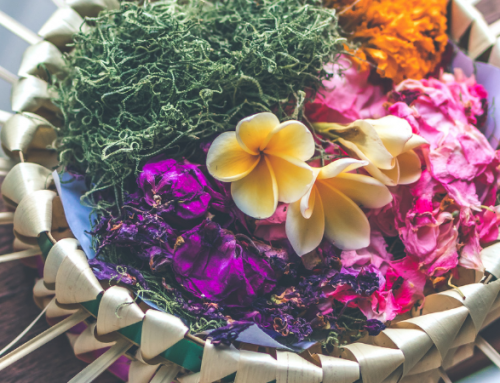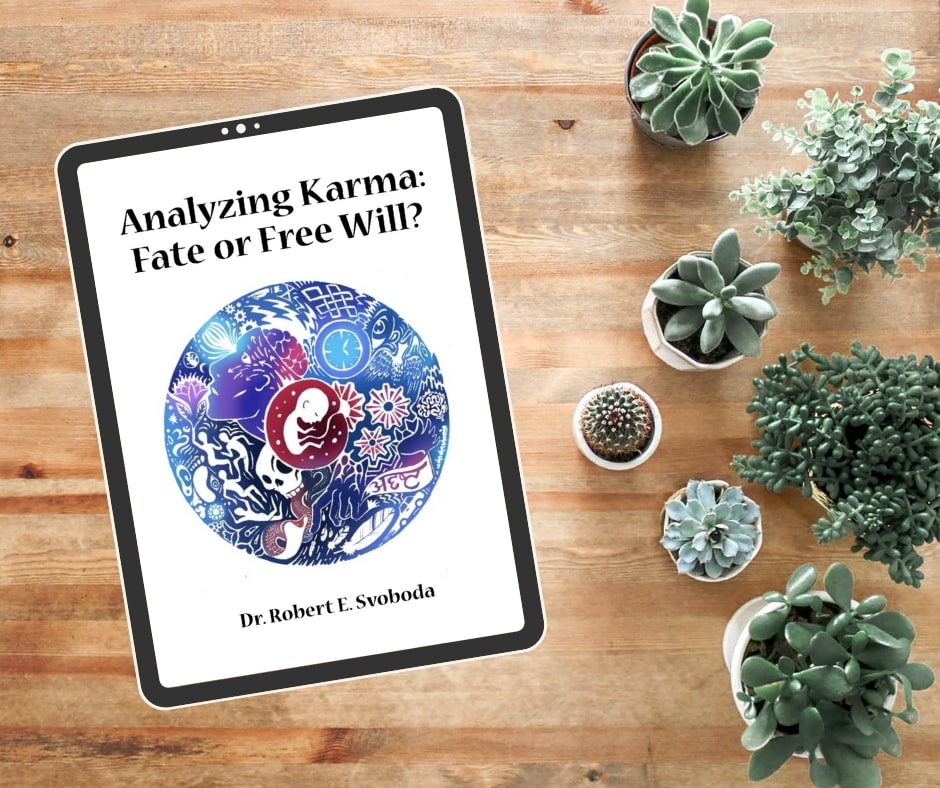Ayurveda Under Cultivation
An aranyaka is an ancient Vedic text that was composed in, and meant to be studied in, a forest. Though the texts of classical Ayurveda were written with urbanites in mind, they are verily aranyakas in spirit, for they carry to city dwellers an urgent “back to Nature” message. To better access that message let us for a moment remove ourselves from the metropolis, and imagine that we are seated under a spreading banyan tree that shades an Ayurvedic guru’s ashram.
The guru sits, dispensing teachings and healings, inspired by the tree’s prana, guided by its intelligence, permitting the natural curative energy of the universe to flow through into student and patient, resisting the blandishments of the ego that yearns to claim doership. Ayurveda herself is a living entity – we can call her the Ayur Vidya – who, being an innate property of the cosmos, exists mainly in the non-physical world. She develops and spreads in our world with the help of suitable hosts, sending her shakti into both the substances used in healing and the healers who use those substances, facilitating healthy relationships between those roots and fruits that are administered and the hands that administer them. The wise practitioner of Ayurveda seeks only to serve as a fit vessel for her wisdom, rather to pretend any personal capacity to accomplish anything.
The Ayur Vidya also projects herself into the consensus realities of cultures and communities, where she embodies herself in medical systems and traditions. Like a tree, the Ayur Vidya seeks to establish herself wherever she can; and in locations where conditions favor her growth she puts down roots, gathers momentum for development, and slowly builds for herself a canopy of principle and practice.
Urged by compassion for living beings, the Ayur Vidya long ago extended herself out from the Indian subcontinent into other Asian regions. Now, at long last, she has begun to seed herself into lands yet more distant. In some locations her seed has fallen on barren ground; in others it has sprouted, then failed to thrive. In a few places, such as at The Ayurvedic Institute along the banks of the Rio Grande in New Mexico, Ayurvedic groves have established themselves.
We may find, on peering into a wood, that individual trees so fixate our attention that it enfeebles our vision of the forest as a whole. Similarly, evaluations of individual Ayurvedic institutions can obscure our attempts to evaluate, accurately and objectively, the condition and direction of “modern” Ayurveda, and how well or poorly it is developing overall. At the risk of going out on our analogy’s limb, and keeping a wary eye on our conceptual bough to prevent it from breaking, let us glance over the expanse of the Ayurvedic garden that stretches out before us, to see how it is evolving.
Any wise gardener looks to the soil to know which plants will be most welcome therein; and when we look to the soil in which knowledge crops are sown we find, throughout the West and particularly in the USA, a predominance of weeds. Weeds grow hurriedly, crowd out competition, reproduce hastily, and swiftly die. Weeds are propagation machines, specializing in extension into every nook and cranny, that offer nothing in return by way of shade, and little in the way of sustenance.
One unfortunate Western tendency is to take sophisticated, subtle bodies of knowledge and “weed-ify” them. This procedure, which Americans have honed to perfection, selects from the teachings to be “streamlined” a few salient points that meet the test of immediate applicability, blends these items into a simplified, “rationalized” protocol, then broadcasts it to the widest possible audience. Yoga has already been extensively subjected to this process; Ayurveda’s turn has now arrived. Open any “New Age” publication and you will find within a plethora of advertisements for Ayurvedic practitioners, counselors, body workers, and detoxification specialists. New “Ayurvedic” supplements appear daily, and spas of every ilk are rushing to add “panchakarma” treatments to their product lines. Sadly, the majority of these resources are Ayurvedic in name alone.
There was a time when thinking of this blatant misbranding would render me apoplectic; but advancing maturity has increased my reluctance to waste energy, and I have learned that the best response to such deception is to ignore it, while sticking resolutely to the high road of teaching Ayurveda in as pure and detailed a manner as is possible for me. The Ayurvedic Institute, which remains one of the few centers of serious Ayurvedic study in the West, shares this determination with me, and it has been my pleasure, during the past two decades of my association with the Institute, to watch the quality of student there progressively improve. Graduates of the Institute have to my mind a certain responsibility to the Ayur Vidya to assist other students of Ayurveda to send their roots deeper into the system’s soil. Deep roots protect a plant from damage when the inevitable storms (regulatory, economic, socio-cultural) sweep through; plants with shallow root systems may get easily uprooted and upended, but the deeply rooted, even if broken off at ground level, survive to sprout again.
Concerned by the seeming tenuousness of Ayurveda’s hold here, some people believe earnestly that working to regularize the profession, by establishing registration and licensing procedures in key states, is the best use of our currently limited resources. But what will Ayurveda gain if its practitioner rolls are padded by “grandfathering in” ill-trained, incompetent therapists? I believe rather that the Ayur Vidya knows well what she is doing, and that we humans need to be careful not to let our current ambient climate of generalized fear extend to her and spur us into taking actions that, by diluting the depth and breadth of her knowledge, will be to her ultimate detriment.
Rather than rush to licensing, I maintain that we should focus instead on using what energies and funds we possess to establish and build up standards, slowly and scrupulously, in a progressive, time-bound fashion, that we as a profession may be well prepared for registration when licensing finally comes to call. One possible approach: establish an accreditation committee that would encourage schools of Ayurveda to accept voluntarily a set of basic standards that the committee would recommend, standards that could become progressively more stringent over a reasonable timeline. This method could allow improvements to occur “organically,” under the direction of the Ayur Vidya, rather than artificially, by legislation.
A perpetual gardening temptation is to try somehow to “improve” upon Nature; with the rise of chemical farming, this “progressiveness” has introduced herbicides, pesticides, fertilizers, genetic engineering, and similar poisons into our external environment. In the internal environment the desire to “develop” tends to embody as the drive to “modernize.” Some aver that Ayurveda’s advanced age has led to decrepitude, for which the remedy is an injection of contemporary techniques; others suggest that Ayurveda should be stripped of its “unscientific” concern for mind and spirit. A substantial cohort maintains that patients should be provided whatever they demand, and since a majority demands “modern” medicine, they should have it. These and similar arguments were raging in India in 1974 when I entered the Tilak Ayurveda Mahavidyalaya in Pune; they continue to rage there even now.
Hybrids can be beautiful, and sometimes tasty, like the tangelo; all too often, though, they are ornery and barren, like the mule. In the course of its long history Ayurveda has more than once succeeded in integrating new techniques into its canon without ever being required to jettison its principles in the process. It has been able to do so because its aficionados have devoted themselves to the Ayur Vidya, making her study into a sadhana, permitting her to determine how and when to augment her own armamentarium. Left to its own devices, provided with ample time and space, and supported with judicious quantities of food, water, sunshine, and love, even a plant from far away can be naturalized locally; this could well become the Ayur Vidya’s Western destiny.
Ayurveda in the West has made immense strides since that day in early 1973 when I strode into the corporate offices of the American Medical Association in downtown Chicago to ask what they knew about it. After half an hour’s wait the receptionist returned with a quizzically weary facial expression to report that could tell me no more than that Ayurveda was “some kind of tribal medicine.” The tree of Ayurveda in the West remains but a sapling, bursting with enthusiasm but still requiring judicious guidance and protection. I believe that the Ayurvedic community should temper any impatience for “progress” with an awareness of the magnitude of the task that has been undertaken, and return often to the banyan’s shade, to tap into the Ayur Vidya’s limitless font of wisdom. Thus refreshed we can proceed calmly, implacably forward, inspired and directed by that very Ayur Vidya that we seek sincerely to serve.
Copyright © 2004
Robert Edwin Svoboda



